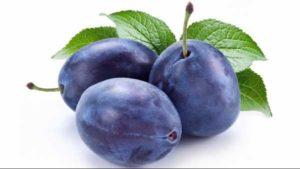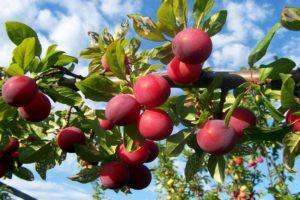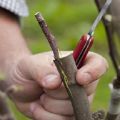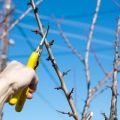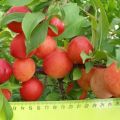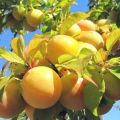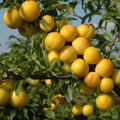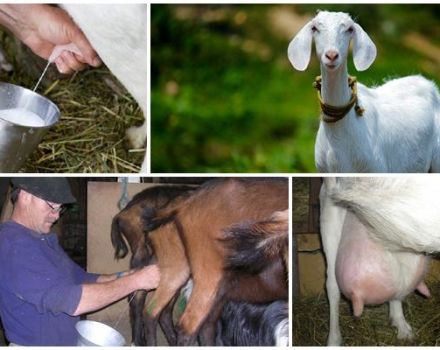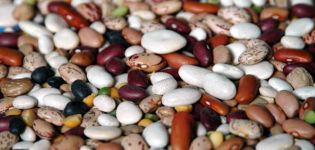How to plant plums correctly in summer, spring and autumn, methods and technologies for beginners
Grafting of fruit trees is used by those who are not afraid to change the varietal characteristics of the plum. After all, cuttings from different trees can be grafted onto one tree. Then, after the procedure, fruits are harvested, different in shape and taste. And for the culture it is an opportunity to recover, to become more resistant to adverse weather conditions. But before starting any actions, you need to know everything about how to plant a plum, which crop is better and in what way.
What time of year to carry out the procedure
It is necessary to determine the timing of vaccination taking into account the region in which the stone fruit culture is grown. Spring grafting is most common, since the tree will recover faster due to increased sap flow. But autumn and summer also cannot be written off.
The phases of the moon also determine when it is best to vaccinate. The procedure is more successful in the growing month. Weather conditions are also taken into account. The day of the vaccination should not be too cold or hot.
In the spring
The most chances for the success of the procedure will be in the first months of spring. The end of March - beginning of April is considered optimal. At this time, the tree is full of strength, and the plum will recover quickly. Operation can be performed in May, but only in cold weather. Otherwise, the plum may wither away, or there will be no sense in vaccination.
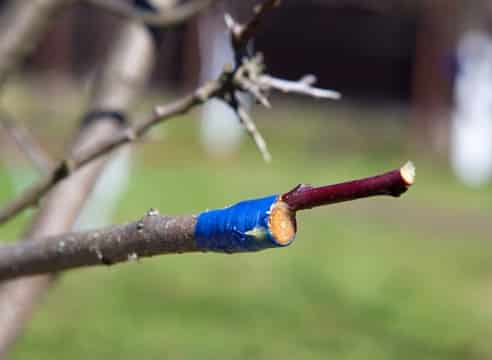
Summer
The summer operation takes place only if it was not possible to carry it out in the spring. Often spring grafting does not always go well, the stalk does not take root. Then it is worth postponing the procedure for the summer. The ideal time would be June or July for temperate regions. Then the survival rate of the scion will increase before the onset of a cold snap. In warm areas, it is possible to plant plums in August as well.
In autumn
It is not recommended to plant plums in autumn. Even if the operation is carried out in September-October, the tree will not have time to recover after the procedure. And the vaccination will be ineffective.

How to prepare cuttings
As a scion, cuttings from lignified shoots of one- or two-year-old are used. It is better to cut from the side branches and from the sunny side of the tree. This should be done in the fall, before the first drop in temperature occurs. Cuttings that are ready for hibernation will better survive and remain viable until spring. They can be saved:
- in grooves lined with spruce branches, covered with earth and straw on top;
- on the balcony, tied in bunches;
- in a basement or cellar;
- on the bottom shelf of the refrigerator.
The main requirement for storage is an air temperature of at least 0 degrees and a humidity of 70%.
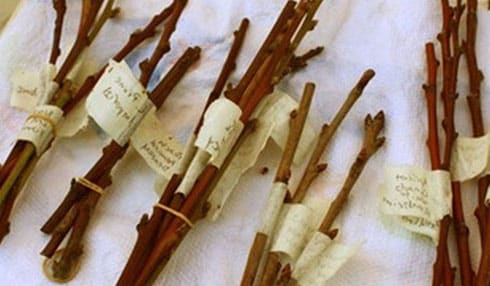
As many cuttings as possible should be harvested, as many can come out of storage with damage and rot.
Types of rootstocks
It is best to plant plums on related trees. Better if it is a wild or semi-cultured. The resulting tree will have the taste of the grafted cultivar, but it will be characterized by winter hardiness and durability. In addition to stone fruit crops, pome fruit can be used as a stock, but the survival rate of the cuttings will be worse. So you can use rootstocks that are close to plums. These include bird cherry, cherry, apricot and peach varieties.
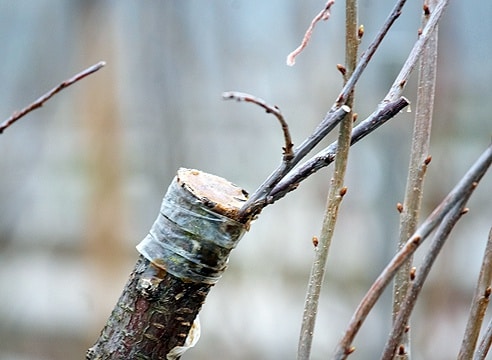
Plums on plums
One of the successful operations is when one variety of plums is grafted onto another, resulting in a wonderful hybrid. The peculiarity of the plum obtained will be the best qualities of the parents. You can not limit yourself to one handle, but use several. Then the variety of fruits on the plum will be interesting.
On the turn
The closest relative of the plum is characterized by the fact that the shrub is unpretentious, resistant to low temperatures. If you want a plum variety that bears fruit in the southern regions, then you can graft a stalk from it onto a thorn. The operation will be successful in any case.
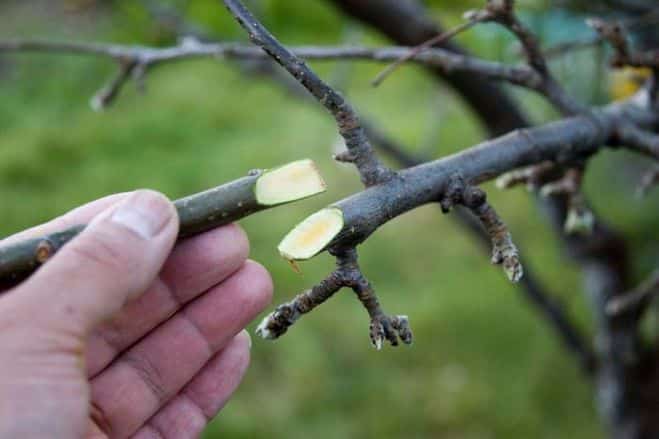
Into the wild
Wild plum varieties are used for rootstock when it is necessary to improve such qualities as strong immunity to diseases and pests. Wildlife is characterized by persistent tolerance to cold climates, temperature extremes, and high humidity.
Novice gardeners need to use this type of rootstock for training in vaccination.
For bird cherry
Although it is possible to use a bird cherry tree as a rootstock, the vaccination will not give a positive result. The resulting fruit tree specimen will not produce good fruit. And the plant will hurt, develop poorly.
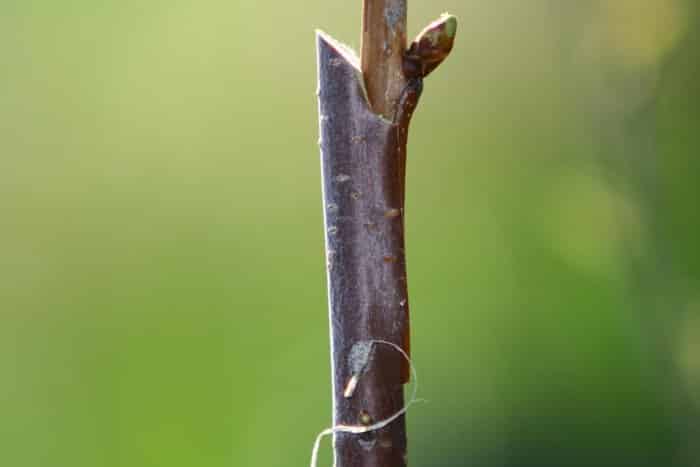
Cherry
Of all types of cherries, it is better to choose felt cherries for grafting plums. But at the same time, the operation requires precision and accuracy. Only then will the plum stalk take root. The advantage of the operation will be the short stature of the hybrid, its early maturity.
On apricot
If the grafting is successful thanks to the correctly selected varieties of plum and apricot, their compatibility, then the summer resident will receive a wonderful hybrid. Although the wood will be more suitable for warmer climates, the aroma and taste of the fruit will become superior.
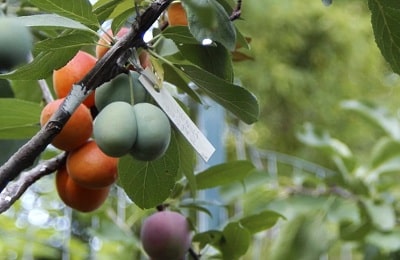
On yellow
The unusual color of the fruit is obtained after inoculation of the blue plum and yellow varieties. The operation is usually successful, and the stalk takes root quickly. But it is best to graft not on a seedling, but on an adult tree.
On a peach
To carry it out correctly, you need a variety that is ideal for merging with a plum. It is best if it is a semi-culture. Still, the peach tree rarely serves as a rootstock. It is better to graft a peach stalk on a plum, then there will be more sense.
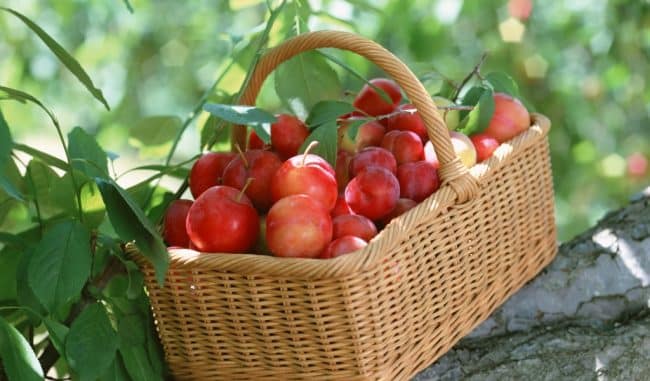
On cherry plum
A short stock is suitable for cutting a plum and the operation is successful. The survival rate is high, since both cultures are related.
Stock preparation
Choose a tree for the stock that will:
- without damage to the bark;
- with a strong immune system;
- ages from 2 to 5 years.
Only a young healthy plum tree can give strength to the grafted cuttings, if the operation was carried out correctly. There is no doubt about the success of the procedure if the vaccination technology is followed, especially for novice gardeners.
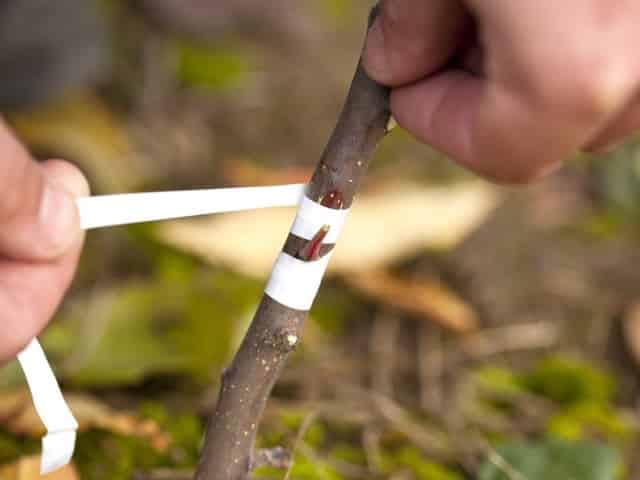
Vaccination methods and technology
There are many ways of how to inoculate plums step by step. It all depends on the experience of the gardener, his practical skills. For beginners, it is better to choose easy methods of vaccination, then move on to more complex ones.
Ablactation
Ablactation is also called a method of bringing horticultural crops closer together. The method can be used when you need to create a row of plum hedges.On the shoots growing nearby, incisions are made, connecting the scion together with the stock. Having folded the layers of cadmium correctly and securing the place of convergence with electrical tape, a new hybrid is obtained.

Copulation
One of the common and simple methods of grafting plums is that:
- The thickness of the rootstock and the scion should be almost the same.
- Cuttings with 3-4 buds cut from annual shoots are suitable for scion.
- At the top, the cutting is cut over the bud.
- Cuts are made obliquely with the length of the cutting diameter - 3-4 centimeters. The scion should have a bud on the back side.
- On the cuts, a tongue is made from the bark with a length of 0.5 centimeters. Cut from top to bottom under the middle lobe of the plane.
- Bending back the tongue, the scion and rootstock sections are connected with the coincidence of the cadmium layers.
- Tightly connect the place with a washcloth and adhesive plaster.
As soon as there is an increase, the winding material is cut across.
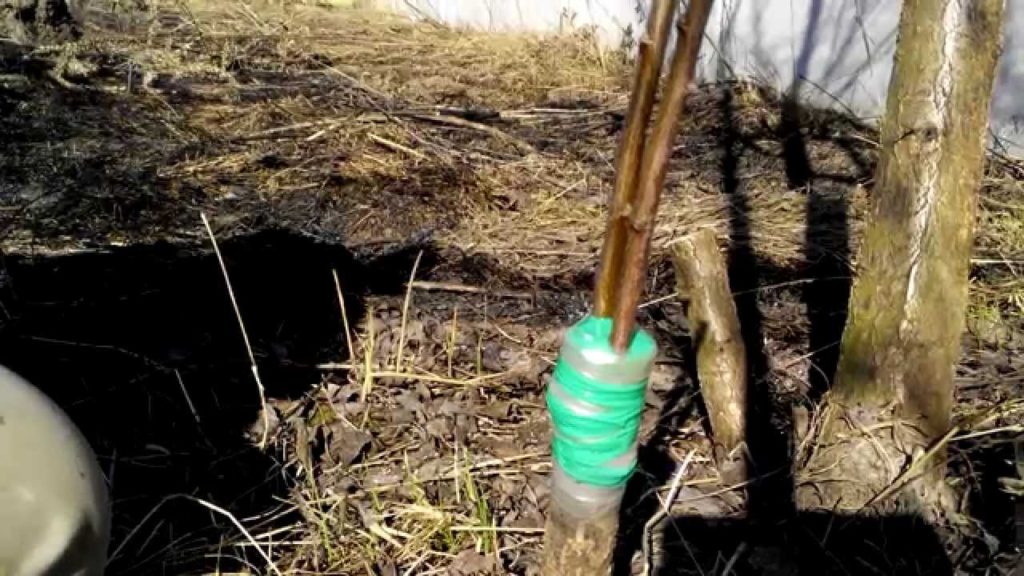
Budding
Budding is carried out by grafting a peephole or bud of the selected plum variety. The thickness of the stock should be 1 centimeter, a recess is cut out on it and a shield with a bud is inserted into it. The junction is fixed with a special tape, leaving the eye open. Vaccination can be carried out in the fall, then in the spring the bud will sprout. A peephole taken in the spring is suitable for a summer procedure.
Shank
It is also possible to graft a plum with a cuttings when the thickness of the stock is 2 times greater than the scion. Then an oblique cut is made on the tree, and then the width of the cut plane is reduced by a second cut at an angle of 30 degrees. In this case, the width of the remaining plane will correspond to the thickness of the cutting. The rest of the procedure is performed as in copulation.
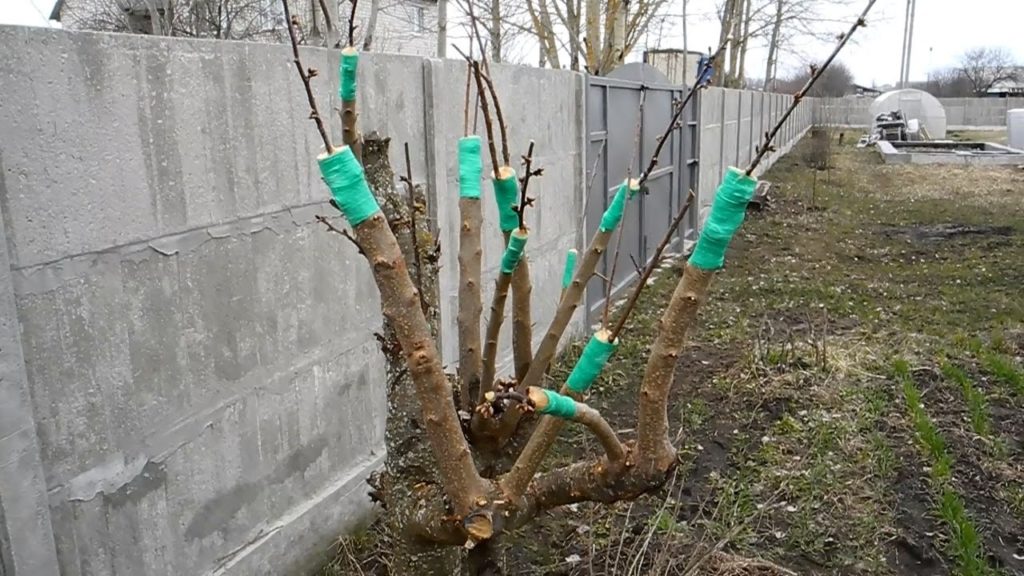
Kidney
They are inoculated with a kidney or an eye on a bark shield, and so:
- make a T-shaped incision on the stock;
- fold back the bark layer;
- insert a shield with a kidney there;
- the vaccination site is rigidly fixed with PVC tape.
It is better to vaccinate on young plum shoots in August.
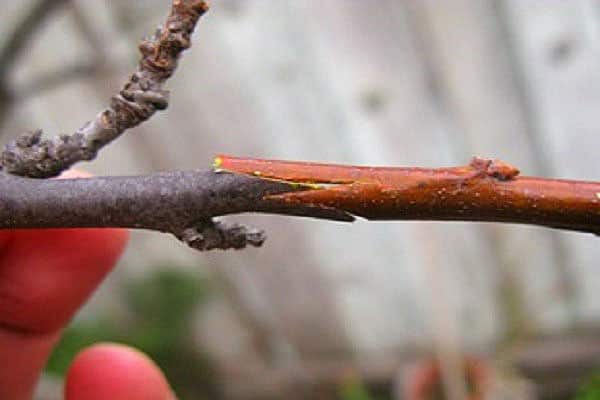
For the bark
If the thickness of the selected rootstock is from 2 to 4 centimeters, then grafting technology for the bark is suitable. The bark is incised across the length of 2-3 centimeters. With a thin cuttings, the bark is separated from one side. For a better connection of cadmium in a thin cuttings, the bark layer is removed. A stalk is inserted by the bark, the grafting site is tied up and coated with garden varnish. Be sure to make sure that the entire oblique cut of the scion goes under the bark.
Into the cleft
This technology will allow several plum cuttings to be planted. The rootstock branch is cut down transversely and straight. In the middle, slices are split perpendicularly. A wedge is made at the bottom of the cutting, with which it is inserted into the split so that the cadmium layers coincide. Then comes the processing with pitch and strapping of the junction.
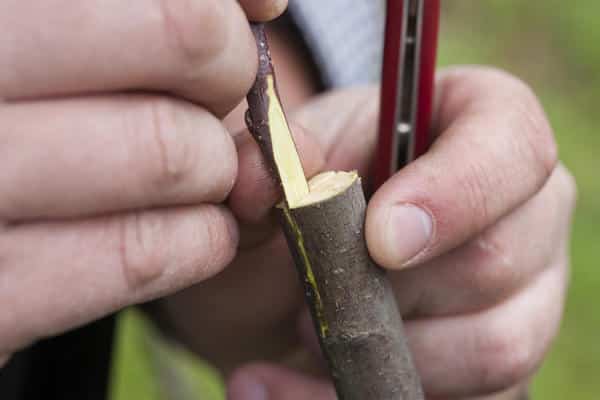
Side cut
This method is needed when the thickness of the stock is at the level of 2.5-3 centimeters. The cut is made with a sharp knife, placing it at an angle of 20-25 degrees relative to the rootstock axis. It is enough to cut to a depth of 5-8 millimeters. Turning the knife, fold back the trimmed part. Then a wedge is made down on the scion, which is inserted into the side cut. When the planes coincide, the strapping is made and covered with pitch.
By the bridge
In the butt, or with a bridge, the stock is prepared by cutting it across with a slight inclination of the butt to one side. On the higher side, the bark and part of the wood are cut longitudinally, and the tongue is cut. The slice width corresponds to the thickness of the grafting cuttings. And the length will be 2-3 centimeters. Having connected the stalk with the stock, tied it with a washcloth, covering it with garden pitch on top. The upper end of the plum stalk and the end of the rootstock are also coated.
How to care for a tree after grafting
After the operation, the drain should be carefully looked after. They also monitor the condition of the grafted cuttings. If leaves appear from the buds on it, then engraftment has begun. Then the strapping is loosened or removed by cutting it across. If a large stalk was grafted, then you can only loosen the tape, but not remove it.
To exclude the weakening of the tree by grafting, it is necessary to free it from excess growth, inflorescences and fruits that have appeared.
